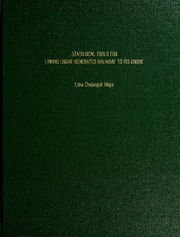
Statistical Tools for Linking Engine-Generated Malware to Its Engine PDF
Preview Statistical Tools for Linking Engine-Generated Malware to Its Engine
Digitized by the Internet Archive in 2012 with funding from LYRASIS Members and Sloan Foundation http://archive.org/details/statisticaltoolsOOmilg Columbus State University The College ofBusiness and Computer Science The Graduate Program in Applied Computer Science Statistical Tools for Linking Engine-generated Malware to its Engine A Thesis in Applied Computer Science by Edna Chelangat Milgo Submitted in Partial Fulfillment ofthe Requirements for the Degree of Master of Science December 2009 )2009 by Edna Chelangat Milgo I have submitted this thesis in partial fulfillment ofthe requirements for the degree of Master ofScience Date Edna Chelangat Milgo We approve the thesis ofEdna Chelangat Milgo as presented here. Qg^Ja f2tial Date Mohamed R. Chouchane Assistant Professor ofComputer Science, Thesis Advisor 3.-61 " looS ( Date Edward L. Bosworth, Associate Professor of Computer Science Date Jianhua Yang, Associate Professor of Computer Science l^loi IX* '1 Date Lei Li, Associate Professor ofComputer Information Systems Management Ill ABSTRACT Malware-generating engines challenge typical malware analysts by requiring them to quickly extract and upload to their customers' machines, a signature for each of a possi- bly vast number ofnever-before-seen malware instances that an engine can generate in a short amount oftime In this thesis we propose and evaluate two methods for'linking va- riants of engine-generated malware to its engine. The proposed methods use the w-gram frequency vector (NFV) of the opcode mnemonics of an engine-generated malware in- stance as a feature vector for the instance. An NFV is a tuple that maps «-grams with their frequencies. The in-formation contained within the NFV of an engine-generated malware instance is then used to attribute the instance to the engine. The first method im- plements a Bayesian-like classifier that uses 1-gram frequency vectors of programs as feature vectors. This method was successfully evaluated on a sample of benign programs and one of malicious programs from the W32. Simile family of self-mutating mal- ware. The second method, which is an extension of the first method, uses optimized 2-gram frequency vectors as feature vectors and classifies malware by computing its proximity to the average of the NFVs of instances known to have been generated by a known engine. The second method was successfully evaluated on four ma)ware-generating engines: W32 Simile, W32.Evol, W32.NGCVK, and W32.VCL. . The evaluation yielded a set offour 17-tuples ofdoubles as signatures for each ofthe en- gines, and achieved a 95% discrimination accuracy between a sample ofbenign programs and samples of malware instances that were generated by these engines. Accuracies of 94.8% were achieved for engine signatures of size 6. 8 and, 14 doubles. We also used
